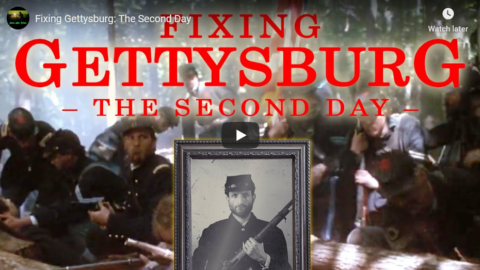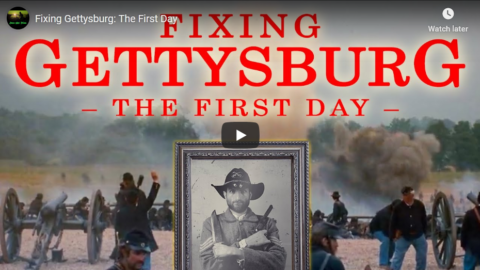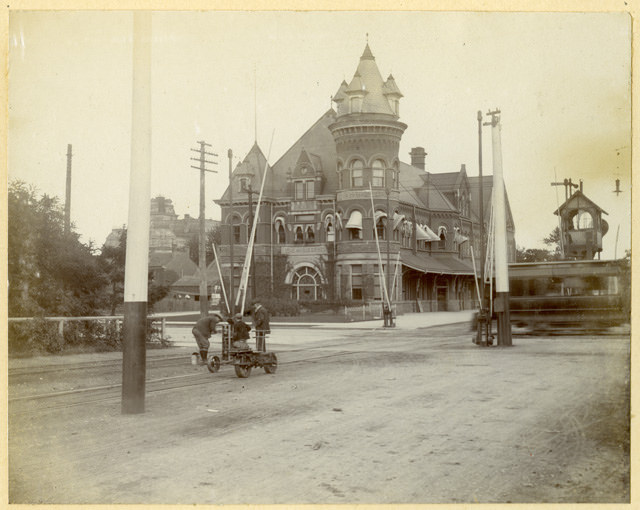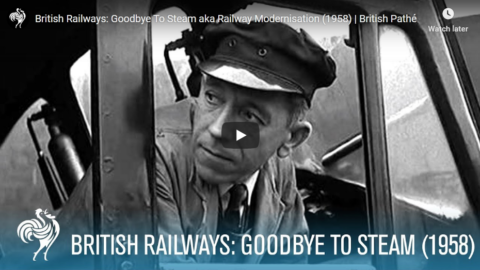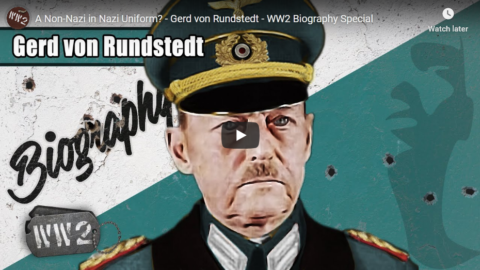Here is what male speech means.
1. “Exactly what I said” — 75% of the time.
2. “Apparently I have not said the right thing yet, because your panties are still on” — 15%.
3. “My God, you’re still talking. You make me wish I had a tranquilizer gun. Doesn’t it ever stop? Jesus, I hope you didn’t say anything important, because all I hear is a buzzing sound. Did I say ‘okay’ or ‘mm-hmm’ or just grunt last time? I better mix it up, or you’ll realize I’m watching the game” — 10%
That covers it.
Steve H., “Traitor in Your Midst: She Must be Dealt With”, Hog On Ice, 2005-02-17.
July 4, 2020
QotD: Interpreting what men say
July 3, 2020
Fixing Gettysburg: The Second Day
Atun-Shei Films
Published 2 Jul 2020In this three-part series, I review a classic Ron Maxwell film about a little known historical event that no one talks about called the Battle of Gettysburg. I also present an abbreviated and oversimplified history of the battle, while simultaneously criticizing the movie for presenting an abbreviated and oversimplified history of the battle.
In the second episode, I discuss the first day of fighting on July 2, 1863 – including Dan Sickles’ shenanigans on the left, the 20th Maine on Little Round Top, the 1st Minnesota, and the night battle on Culp’s Hill.
Support Atun-Shei Films on Patreon ► https://www.patreon.com/atunsheifilms
Leave a Tip via Paypal ► https://www.paypal.me/atunsheifilms (Between now and October, all donations made here will go toward the production of The Sudbury Devil, our historical feature film)
#Gettysburg #CivilWar #VideoEssay
Watch our film ALIEN, BABY! free with Prime ► http://a.co/d/3QjqOWv
Reddit ► https://www.reddit.com/r/atunsheifilms
Twitter ► https://twitter.com/atun_shei
Instagram ► https://www.instagram.com/atunsheifilms
Merch ► https://atun-sheifilms.bandcamp.com~REFERENCES~
[1] Stephen W. Sears: “General Longstreet and the Lost Cause” (2005). American Heritage Magazine https://www.americanheritage.com/gene…
[2] W.C. Storrick: The Battle of Gettysburg (1931). J Horace McFarland Company, Page 26
[3] Frederick Tilberg, Scott Hartwig, John Heiser: Gettysburg National Military Park Handbook (2013). Historic Map and Print Company, Page 31-32
[4] Storrick, Page 27
[5] William B. Styple: Generals in Bronze (2005). Belle Grove Publishing Company, Page 222
[6] “The 1st Minnesota Infantry at Gettysburg” (2014). Iron Brigader https://ironbrigader.com/2014/01/03/1…
[7] Storrick, Page 29-30
[8] Tilberg, Hartwig, Heiser, Page 45
“Nuclear Attack” – Atomic Bombings – Sabaton History 074 [Official]
Sabaton History
Published 2 Jul 2020At 0815 on 6 August 1945, the first atomic bomb, nicknamed “Little Boy”, was dropped out of the B-29 Enola Gay and descended towards the Japanese city of Hiroshima. 43 seconds later, the city was engulfed in a flashing bright light and a shockwave of unimaginable heat and deadly pressure. From the hypocenter of the resulting mushroom-cloud, a blue-green fireball burned and blinded the city and its inhabitants with unprecedented power. 140,000 people were killed in the first few moments. Tens of thousands would die from wounds and radiation. The age of atomic warfare had begun.
Support Sabaton History on Patreon: https://www.patreon.com/sabatonhistory
Listen to “Nuclear Attack” on the album Attero Dominatus
CD: http://bit.ly/AtteroDominatusStore
Spotify: http://bit.ly/AtteroDominatusSpotify
Apple Music: http://bit.ly/AtteroDominatusAppleMusic
iTunes: http://bit.ly/AtteroDominatusiTunes
Amazon: http://bit.ly/AtteroDominatusAmzn
Google Play: http://bit.ly/AtteroDominatusGooglePlayListen to Sabaton on Spotify: http://smarturl.it/SabatonSpotify
Official Sabaton Merchandise Shop: http://bit.ly/SabatonOfficialShopHosted by: Indy Neidell
Written by: Markus Linke and Indy Neidell
Directed by: Astrid Deinhard and Wieke Kapteijns
Produced by: Pär Sundström, Astrid Deinhard and Spartacus Olsson
Creative Producer: Joram Appel
Community Manager: Maria Kyhle
Executive Producers: Pär Sundström, Joakim Broden, Tomas Sunmo, Indy Neidell, Astrid Deinhard, and Spartacus Olsson
Post-Production Director: Wieke Kapteijns
Edited by: Iryna Dulka
Sound Editing by: Marek Kaminski
Maps by: Eastory – https://www.youtube.com/c/eastoryArchive by: Reuters/Screenocean https://www.screenocean.com
Music by Sabaton.Colorizations:
– Dememorabilia – https://www.instagram.com/dememorabilia/Sources:
– U.S. Department of Energy
– Bomb icon by P Thanga Vignesh from the Noun Project
– bockelsound from freesound.org
– Vilna Gaon State Jewish MuseumAn OnLion Entertainment GmbH and Raging Beaver Publishing AB co-Production.
© Raging Beaver Publishing AB, 2019 – all rights reserved.
From the comments:
Sabaton History
2 days agoAugust 6, 1945. On this fateful Monday morning our world changed forever.
Nuclear weapons were now a reality, destruction on a whole new level a possibility. International power dynamics, foreign politics and conflict handling would never be the same once this new kind of weapon of mass destruction had entered the scene. The threat of potentially world-ending nuclear war, the fear that the men in power would push “the red button”, would hang over people like a dark cloud from this day on. The Nuclear Age had begun.
If you’re interested in how politics developed during The Nuclear Age, you can explore that in the day-by-day coverage of The Cuban Missile Crisis over on TimeGhost History. The first introduction, “USA Starts the Atomic Arms Race”, is already up and you can watch it right here: https://youtu.be/zEXjoBe5ZdI
Birth, rapid growth, profitable stasis, bureausclerosis, decline, death – typical tech firm lifecycle
In the Continental Telegraph, what looks to be a pretty solid characterization of the corporate life-cycle for technology firms:
There are generally, 6 stages in the life of a tech company:
- Inception. A couple of smart kids start something in a garage. Massive innovation.
- Fast growth. The business moves to some good offices, number of staff increases. They take on smart, fast moving people who are innovating big. A few people know them.
- Steady growth. The business is now something of a household name. They get their own small head office. Staff are more like normal business. Innovation continues, but the bureaucracy starts to grow.
- Bureaucracy. The business is a household name. They have multiple offices, or something designed by a smart-ass architect. There’s still staff coming in, but they’re mostly seeing it as a nice warm place to sit and be bureaucrats. The innovators start leaving as it’s just not interesting. They might even be making lots of money, but it’s mostly just living off what was built in earlier phases, or large dumb wasteful projects that go nowhere for years.
- Decline. A new disruptor arrives on the scene. They innovate in a field you’re involved in. You can’t keep up because in the previous phase, you replaced the innovators with bureaucrats. You’re outsmarted.
- Terminal decline and death. You slowly or quickly disappear, maybe holding onto a few customers who habitually use you.
I think there might also be something about when government starts taking an interest in you, and I think it’s quite some time into stage 4. Google are already there. Firing James Damore is very much bureaucracy state behaviour. They wouldn’t have cared when it was a tiny number of staff in an office. And how much have they really innovated in the last decade?
The History of: The British 1942 Battle Jerkin & Skeleton Battle Jerkin | Uniform History
Uniform History
Published 24 Mar 2020The start of another two parter, in this one we cover the British Battle Jerkin family as it helped inspire the US Normandy Assault Vest’s creation.
Music by: https://www.juliancrowhurst.com/
QotD: Pop music
The thing I always hated hearing from my grandfather was how modern music was terrible and not fit for civilized people. He was a man of his age and class, so he used colorful euphemisms to describe popular music. Even as a kid, I understood that every generation has their soundtrack. Maybe never having known anything but a world where pop culture dominated, this came naturally to me, while my grandfather still recalled an age before everyone had a radio and television. Maybe he knew things I couldn’t know.
Either way, I’ve always just assumed that once I passed my mid-20’s, pop music was no longer for me. Some stuff would be appealing, but most would be aimed at kids and strike me as simplistic and repetitive. There were some good bands in the 90’s that I liked, but most of it was not my thing. By the 2000’s, I was unable to name popular groups or the songs at the top of the charts. Today, I have not heard a single note from any song on the current top-40. On the other hand, I’m sure I’ve heard some version of all of it.
That may be why music sales have collapsed. A 15-year old can go on YouTube or Spotify and find fifty versions of the current pop hits, going back before their parents were born. They can also find stuff from previous eras that was remarkably well done and performed by people with real talent. Justin Timberlake may be very talented as a singer, but no one is confusing him with Frank Sinatra. It’s simply a lot easier for young people to see that pop music is just manufactured pap from Acme Global Corp.
“The Z Man”, “The Soundtrack Of This Age”, The Z Blog, 2018-03-15.
July 2, 2020
Fixing Gettysburg: The First Day
Atun-Shei Films
Published 1 Jul 2020In this three-part series, I review a classic Ron Maxwell film about a little known historical event that no one talks about called the Battle of Gettysburg. I also present an abbreviated and oversimplified history of the battle, while simultaneously criticizing the movie for presenting an abbreviated and oversimplified history of the battle.
In this first episode, I discuss the first day of fighting on July 1, 1863 – including Buford’s cavalry, the Iron Brigade, the Railroad Cut, and John Burns.
Support Atun-Shei Films on Patreon ► https://www.patreon.com/atunsheifilms
Leave a Tip via Paypal ► https://www.paypal.me/atunsheifilms (Between now and October, all donations made here will go toward the production of The Sudbury Devil, our historical feature film)
#Gettysburg #CivilWar #VideoEssay
Watch our film ALIEN, BABY! free with Prime ► http://a.co/d/3QjqOWv
Reddit ► https://www.reddit.com/r/atunsheifilms
Twitter ► https://twitter.com/atun_shei
Instagram ► https://www.instagram.com/atunsheifilms
Merch ► https://atun-sheifilms.bandcamp.com~REFERENCES~
[1] “General John Buford’s Report of his Cavalry’s Action at Gettysburg” (2015). Iron Brigader https://ironbrigader.com/2015/06/22/g…
[2] W.C. Storrick: The Battle of Gettysburg (1931). J Horace McFarland Company, Page 11
[3] “The First Day at Gettysburg: Then and Now.” American Battlefield Trust https://www.battlefields.org/learn/ar…
[4] “Lt. Colonel Rufus Dawes Describes the Fighting of the 6th Wisconsin Infantry at Gettysburg” (2013). Iron Brigader https://ironbrigader.com/2013/06/13/l…
[5] “Civilian John Burns at the Battle of Gettysburg (2018)”. C-Span https://www.c-span.org/video/?447809-…
[5 1/2] Allen C. Redwood: “The Confederate in the Field”. Civil War Home https://www.civilwarhome.com/confeder…
[6] Codie Eash: “The Wounded Wisconsinite Who Witnessed Pickett’s Charge” (2018). National Museum of Civil War Medicine https://www.civilwarmed.org/reed/?fbc…
[7] Cooper Wingert: “The Confederate ‘Slave Hunt’ and the Gettysburg Campaign” (2020). Emerging Civil War https://emergingcivilwar.com/2020/05/…
Kennedy, the Lying Politician | The Cuban Missile Crisis I Prelude 2
TimeGhost History
Published 1 Jul 2020The Cold War grows gets more and more tense as both the USSR and the US try to get the upper hand through the volume of nuclear weapons and strategic launching sites – including Cuba.
Join us on Patreon: https://www.patreon.com/TimeGhostHistory
Hosted by: Indy Neidell
Written by: Spartacus Olsson
Director: Astrid Deinhard
Producers: Astrid Deinhard and Spartacus Olsson
Executive Producers: Astrid Deinhard, Indy Neidell, Spartacus Olsson, Bodo Rittenauer
Creative Producer: Joram Appel
Post-Production Director: Wieke Kapteijns
Research by: Spartacus Olsson
Edited by: Daniel Weiss
Sound design: Marek KaminskiColorizations:
– Carlos Ortega Pereira (BlauColorizations) – https://www.instagram.com/blaucoloriz…
– Daniel WeissSources:
– New Georgia EncyclopediaSoundtracks from Epidemic Sound:
– “Cold Eyes” – Elliot Holmes
– “Juvenile Delinquent” – Elliot Holmes
– “Nightclub Standoff” – Elliot Holmes
– “Scope” – Got Happy
– “Zoot Suit” – Elliot Holmes
– “Car Chase in Virginia” – White Bones
– “When They Fell” – Wendel Scherer
– “Kissed by Thunder” – Elliot HolmesArchive by Screenocean/Reuters https://www.screenocean.com.
A TimeGhost chronological documentary produced by OnLion Entertainment GmbH.
Fallen flag — the Toronto, Hamilton & Buffalo Railway
 This month’s Classic Trains featured fallen flag is my favourite Canadian railway … I founded the TH&B Railway Historical Society many years ago (you can download a PDF of the first newsletter I did here … I didn’t have access to any TH&B photo I could use in the publication at that point, so it’s pretty much all text and tables). I put together as much information as I had about the railway at that time and printed up a few hundred copies to distribute at a regional railfan event (the CN Lines event in Oakville during October 1997), hoping to find fellow fans of the TH&B (back in those long-distant days when you couldn’t just run a quick search from your web browser, and most people didn’t yet have email addresses). The gamble worked and we had a formal historical society up and running for the following issue. I published the newsletter for five years before finally burning out and handing it over to more capable hands.
This month’s Classic Trains featured fallen flag is my favourite Canadian railway … I founded the TH&B Railway Historical Society many years ago (you can download a PDF of the first newsletter I did here … I didn’t have access to any TH&B photo I could use in the publication at that point, so it’s pretty much all text and tables). I put together as much information as I had about the railway at that time and printed up a few hundred copies to distribute at a regional railfan event (the CN Lines event in Oakville during October 1997), hoping to find fellow fans of the TH&B (back in those long-distant days when you couldn’t just run a quick search from your web browser, and most people didn’t yet have email addresses). The gamble worked and we had a formal historical society up and running for the following issue. I published the newsletter for five years before finally burning out and handing it over to more capable hands.
The society is still in operation, and the newsletter (now called The Ontarian) is mailed out four times per year. Membership information available at the society website.
Greg McDonnell begins the article with a quick look at the TH&B’s early history:
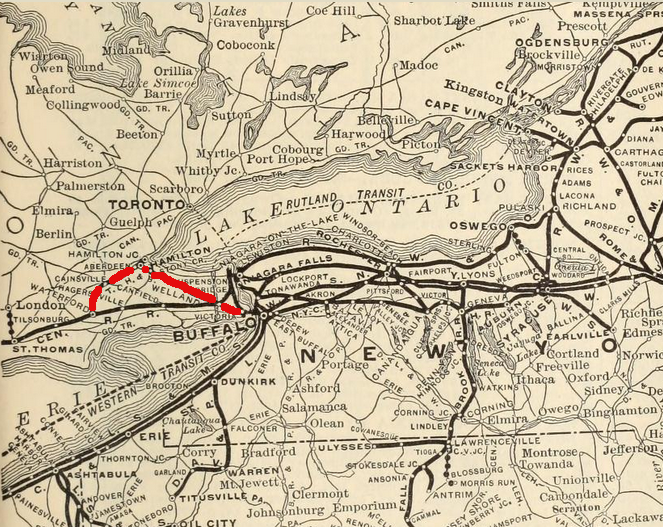
Detail from a map published in The Commercial and Financial Chronicle in 1908. TH&B trackage has been marked in red (not on the original image).
Wikimedia Commons.
Canada, thanks to its two transcontinental giants after 1923, had few small “regional” railroads. One, though, was the 111-mile Toronto, Hamilton & Buffalo Railway, which vanished in 1987.
Little TH&B had a larger-than-life presence that belied the reality of its being merely the southern Ontario stepchild that linked parents New York Central and Canadian Pacific. TH&B never realized its dream of being an independent road linking its three namesake cities, but in its heyday, it did haul sleeping cars from Toronto for New York, Boston, Cleveland, Pittsburgh, and Philadelphia. In 1911, it became the first North American railroad to install Absolute Permissive Block signaling; it erected a splendid art deco station and office tower in Hamilton, Ontario; and it had Canada’s only 2-8-4 steam locomotives, not to mention two ex-NYC Hudsons.
In 1890, even before a rail was laid, TH&B deviated from its chartered intentions, dropping Buffalo from its plans in favor of an eastern terminus and connection with the Canada Southern, a subsidiary of NYC’s Michigan Central, at Welland, Ontario. In 1892, TH&B acquired its first operating trackage, the faltering 18-mile Brantford, Waterloo & Lake Erie, a Brantford–Waterford line that was extending itself to Hamilton.
The original Hunter Street station in Hamilton, replaced in 1929 with the current Art Deco station now operated by GO Transit.
Local History & Archives, Hamilton Public Library via Wikimedia Commons.As crews spiked TH&B rails from Hamilton to Welland, the line’s strategic importance attracted suitors. And not just anyone, for on July 9, 1895, the still-incomplete railway was sold to a consortium headed by two of the most powerful men in North American railroading: NYC’s Cornelius Vanderbilt and CPR’s William Van Horne.
NYC, dividing its holdings with subsidiaries MC and CASO, took a 73% stake in the fledgling bridge line; CP held the remaining 27%, an arrangement that would endure for 80-plus years. TH&B was afforded a considerable measure of autonomy, but parental influence from New York and Montreal gave TH&B its unique international character.
The TH&B Society picks up the history in somewhat more detail (the original draft was mine, but several others have made additions and changes since then):
The next phase of construction was to be the line from Hamilton to Toronto. The surveyed route to Toronto closely paralleled the existing Grand Trunk Railway mainline. In order to avoid construction of a parallel line (and the potential loss of traffic to the competing line), the GTR granted running rights to the Canadian Pacific Railway between Toronto and Hamilton in 1896. That same year the TH&B constructed what became known as the Hamilton Connection between its line and the GTR at Hamilton Junction. The Hamilton Connection was subsequently leased to the CPR and became their physical connection to the TH&B.
In 1897, the TH&B obtained running rights over the Hamilton & Dundas Railway for the provision of freight service into the Town of Dundas. The H&D Railway, a local interurban line, ceased operations in 1923 and the TH&B acquired the former H&D right of way into Dundas to continue freight operations. The line into Dundas was known as the H&D Branch.
In order to tap into Hamilton’s expanding industrial sector, construction began on the Hamilton Belt Line in 1900. The Belt Line expanded with the construction of two additional branch lines in 1911 to allow access to all industrial sectors of the city, many of which were previously serviced exclusively by the GTR. Although the Belt Line was only six miles in length, it contained over 40 miles of yard and industrial sidings and would provide much financial sustenance to the TH&B over the years.
In 1914, the 14-mile Dunnville Subdivision was constructed southward from Smithville to the Town of Dunnville and extended five miles further to the shores of Lake Erie at Port Maitland in 1916. Access to Lake Erie allowed the creation of the TH&B Navigation Co. that operated between Port Maitland and Ashtabula, Ohio, from 1916 until discontinuance in 1932.
The TH&B’s final expansion occurred in 1927 when running rights were awarded over the Canadian National Railways to gain access to the industrial City of Port Colborne.
1935 saw the first abandonment of trackage when the Ridgeville Spur, a small four-mile branch extending off the Welland Subdivision just outside of Welland, was abandoned and the rails were removed in 1936.
The St. Lawrence Seaway Authority completed the construction of the present-day Welland Canal in 1972 resulting in the relocation of several rail lines in the area. The Welland Subdivision was realigned between Fenwick and Welland where a new yard was constructed and operated in conjunction with New York Central’s corporate successor, Penn Central. The new shared facility allowed the closure and removal of the original and independent TH&B and Penn Central operations located within the city. Welland Yard continues to operate today as a Canadian Pacific’s marshalling facility for the Niagara Region.
In 1976, the United States Government amalgamated six bankrupt railroads, including the New York Central’s corporate successor, Penn Central, into a new entity called Conrail. In an effort to reduce debt, Conrail began shedding foreign investments including their controlling interest in the TH&B. In 1977, CP Rail acquired Conrail’s 73% interest giving CP 100% control of the railway.
In 1985, CP Rail and Canadian National jointly acquired the assets of Conrail’s Canada Division, the former Canada Southern Railway. CP Rail acquired exclusive ownership of the eastern end of the line between the TH&B connection at Welland and the international border crossings at Niagara Falls and Fort Erie, Ontario. While CP equipment was used to operate this portion of the line, known as CP CASO, the TH&B provided the managerial and administrative functions on CP Rail’s behalf.
The TH&B would continue to operate as a separate entity until 1987 when it was amalgamated into the Eastern Region of the London Division of CP Rail.
CP Rail abandoned the H&D Branch in 1988 with the Waterford Subdivision following in 1989. Also in that year, CP discontinued operations into Port Colborne, opting not to renew the running rights agreement over the CNR.
Today, the surviving portions of the TH&B, including the Hamilton Belt Line, the former Welland Subdivision and a portion of the Dunnville Subdivision operate as part of Canadian Pacific’s Hamilton Subdivision in CPR’s Southern Ontario Service Area.
Early Automatic Pistol Cartridges – What, When & Why?
Forgotten Weapons
Published 12 Oct 2016http://www.patreon.com/ForgottenWeapons
Cool Forgotten Weapons Merch! http://shop.bbtv.com/collections/forg…
In discussion with a friend recently, the topic of early automatic pistol cartridges came up. Specifically, looking at the context of which cartridges were actually available at which times, and how this might provide helpful context for understanding why particular cartridges were adopted (or commercially successful) or were not.
I decided to see if I could put together a useful video on the subject, and this is the result. We will look at the cartridges available prior to 1900, the ones developed or introduced between 1900 and 1904, and then a few followups which appeared between 1905 and 1910.
Some cartridges became popular because of their ballistic characteristics — like the 7.63mm Mauser and the C96 “Broomhandle” — while others became popular because of the handgun much more than the cartridge itself — like the Browning 1900 and the .32ACP / 7.65mm Browning.
QotD: Army recruits
There have been better attempts at marching, and they have been made by penguins. Sergeant Jackrum brought up the rear in the cart, shouting instructions, but the recruits moved as if they’d never before had to get from place to place. The sergeant yelled the swagger out of their steps, stopped the cart and for a few of them held an impromptu lesson in the concepts of “right” and “left” and, by degrees, they left the mountains.
Terry Pratchett, Monstrous Regiment, 2003.
July 1, 2020
British Railways: Goodbye To Steam aka Railway Modernisation (1958) | British Pathé
British Pathé
Published 13 Apr 2014This archive footage from 1958 depicts British Railways’ journey to modernisation and the transition away from steam-powered trains.
For Archive Licensing Enquiries Visit: https://goo.gl/W4hZBv
#BritishPathé #History #Railway #Trains #BritishRailways
(FILM ID:1549.07)
Full title reads: “Goodbye To Steam”Intertitle reads: “British Railways meet the challenge of the age of abundant power”
Angle shot, railway engine going past camera. GV Outside one of the large London Railway stations showing railway lines and train coming out of station. CU Man in signal box, pan to show him pulling levers. CU Signal going up. GV Train coming towards camera. GV Steam train. GV Aerial shots steam train. CU Man filming from plane. CU man in plane fitting equipment and then giving thumb’s up sign. GV Aerial shot, railway lines. CU Man filming from plane. Steam train going along line. SV Draughtsmen in office. CU Men looking through magnifier at a plan. CU Magnified picture of plan, zoom to show Railway chiefs seated round table with plan, among them is Sir Philip Warter. SV Elevated, railway chiefs looking at plan. CU One of the railway executives. SV Man with model of section of railway line which he places on the table and the railway executives study it. CU Sign reading “Kent Coast Electrification Widening to Provide Four Tracks”, pan to show railway line with only two tracks. GV Kent Coast line with men on bridge. SV Bridge with surveyor. CU Surveyor looking through theodolite. GV Tracking shot of men working. GV Men working at side of railway line with clouds of smoke coming from wood. CU New diesel engine. CU Sir Brian Robertson talking to train driver. CU People watching. CU Sir Brian Robertson blowing whistle. CU Int. diesel engine with driver operating controls. SV Diesel train moving out of station. CU Driver of diesel train. CU. Sir Brian Robertson sitting in carriage. LV Through window of diesel cab as train enters tunnel. SV Three engines on lines. CU Front of one of the engines with plate reading “Cornish Riviera Express”. CU Driver. SV Cornish Riviera Express in station. SV Woman taking in washing because smoke is billowing up from railway lines beside her garden. GV Cornish Riviera Express coming towards camera.
CU Front of steam train “The Bristolian”. SV along top of engine as blows off steam. CU Hand pulling chain. CU valve. GV Platform. CU shovelling coal. GV As train goes along. CU Driver of train. CU Driver. CU Fireman. CU Fire with coal being shovelled. SV Looking over coal tender. SV From driver’s cab of train going under bridge and out the other side. CU Driver. GV From driver’s cab of railway lines with another steam train. SV Int. class for instruction of diesel engine drivers. CU Lecturer talks about metal object. CU Men looking at machinery. SV Royal Scot in station. CU Driver of Royal Scot. GV Activities on platform in which Royal Scot is standing. GV Royal Scot leaving station. GV Building with sign, “English Electric Co. Ltd. Preston”. GV Int. of workshop showing men working on armatures. GV Ext. of building with “Vulcan Locomotives” painted on wall. GV Int. of workshop showing men working on railway engines. CU Man working inside railway engine. GV Workshop. SV Diesel train in station. CU Driver of diesel. GV railway lines in front of train as it moves along. SV Int. dining car in diesel train with attendant pouring coffee. GV Looking through cab window of railway lines in front of train as it goes under bridge and straight past station. CU Glass panel in door with “York Signal Box, Strictly Private”, door opens. SV Man sitting at control panel of box, he reaches over to controls. CU Man’s hands working controls. CU Plan on wall showing different lines and points. CU Hand pushing buttons. CU Signals. CU Point on lines. GV Steam train along lines. CU Train in museum. CU Compartment of old train. SV Ancient train “Locomotion 1828”. SV Diesel Locomotive. CU “Deltic” written on side. GV Deltic. GV Train in station. Various shots in Deltic carriage. SV Coal trucks. SV Railway worker attaching pipe to train. GV Calder Hall Nuclear / Atomic Power station. GV Electrical pylons and cables. GV Diesel train “Sir Brian Robertson” in platform with crowds. GV Crowds. SV “Sir Brian Robertson” unveiled by Mr Grand, General Manager of the Western Region of British Railways. SV Crowd. SV Sir Brian Robertson by train. CU Sign “Sir Brian Robertson”. GV The “Sir Brian Robertson” leaving Paddington Station. SV Steam train letting out smoke. CU Signals. GV Steam train. CU Train over the points. GV steam train leaving clouds of smoke.
BRITISH PATHÉ’S STORY
Before television, people came to movie theatres to watch the news. British Pathé was at the forefront of cinematic journalism, blending information with entertainment.

